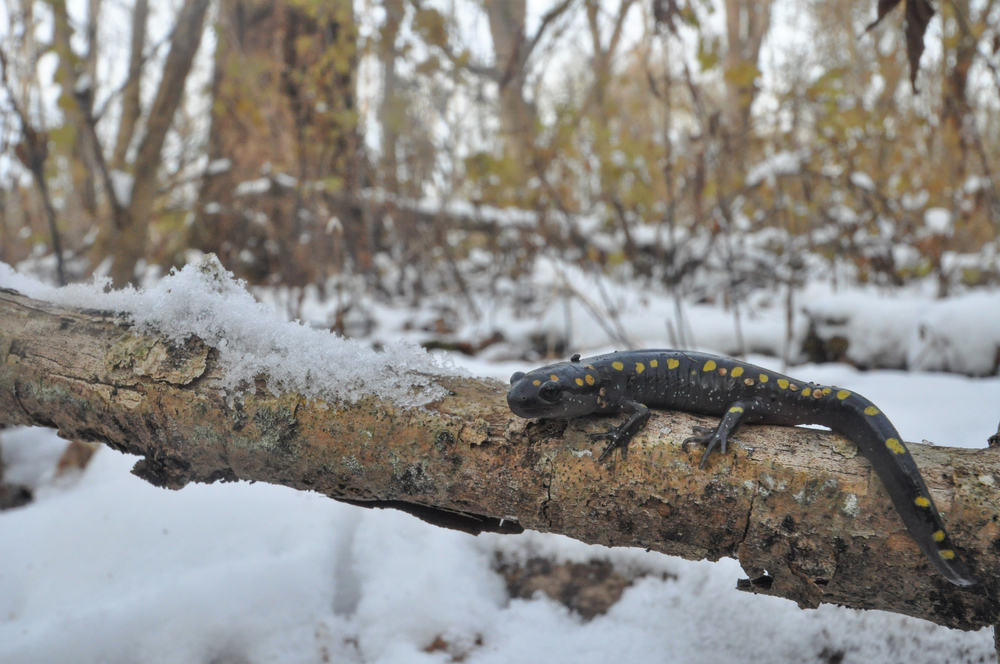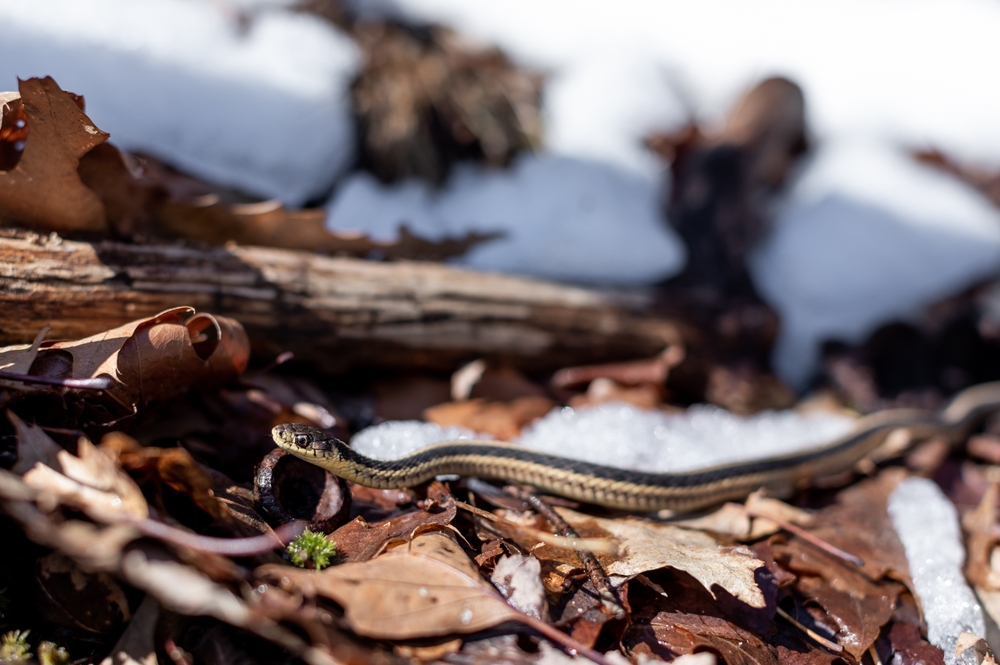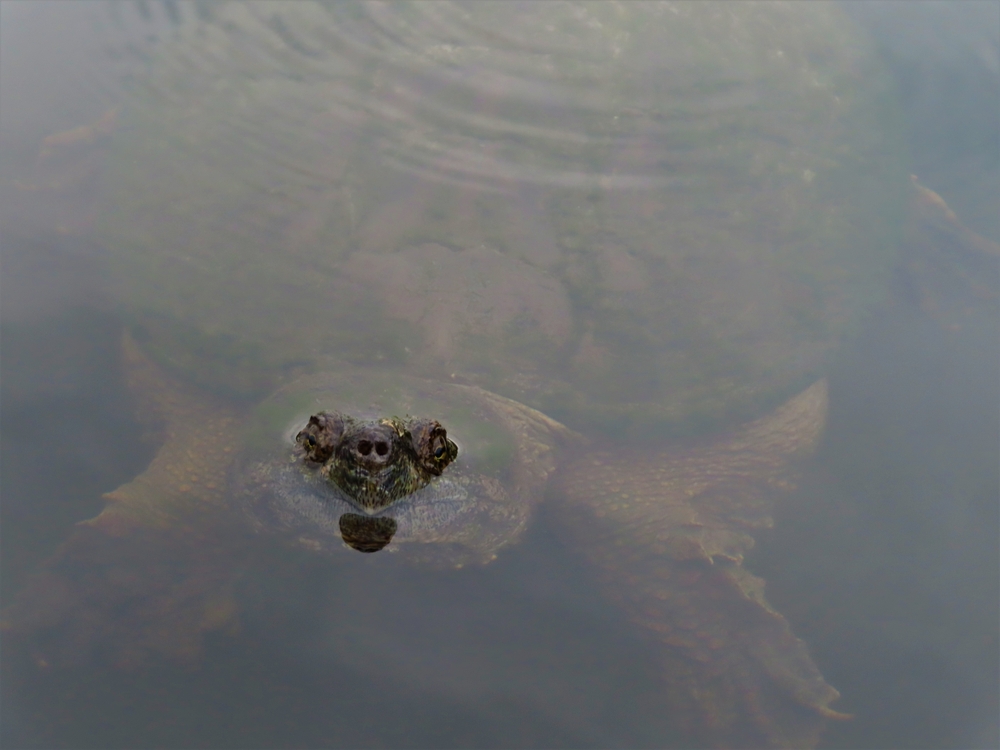January 15, 2024 at 5:55 pm
How do Maine’s Reptiles and Amphibians Survive Winter?
The new year is well under way and so are the winter survival strategies of Maine wildlife. When daylight is in short supply, the snow flies, and temperatures drop, it’s hard not to wonder how wild animals navigate the challenges of winter while we huddle by the fireplace. Birds are famous for remarkable long-distance southward journeys over land and sea to spend the winter gorging on tropical buffets. Maine’s mammals, on the other hand, stick around and tough out the winter, insulated in thick fur coats or saving energy through torpor or hibernation. But what about reptiles and amphibians?

In spring, we hear deafening choruses of calling frogs emanating from vernal pools, but now, silence. In summer, we see lines of basking turtles held afloat by sunny logs, but now, they are nowhere to be seen. Where are they? Migration isn’t a viable option. Just traveling across a single road is a dangerous enough prospect for a salamander, and you certainly don’t see snakes slithering south in “V” formation. Like Maine’s mammals, the only other option for herpetofauna is to stay and endure the elements, and they do so in secrecy with their own unique winter survival strategy- brumation. You can think of brumation as an energy-saving period of inactivity, similar to hibernation, used by ectothermic (cold-blooded) animals to survive the winter. Only reptiles and amphibians that have evolved such strategies are able to call Maine home.
Suspended Animation
One major obstacle for wildlife in winter is low food availability. Migrators deal with this by moving to a place with abundant food before food becomes scarce. Hibernating mammals pack on the pounds in fall, storing up fat reserves which will be used slowly due to inactivity. Reptiles and amphibians must also go into brumation in good body condition, but they rely on stored glycogen, a type of sugar, for energy rather than fat reserves. During brumation, the metabolism of reptiles and amphibians slows to a crawl in response to low temperatures. Respiratory rates reduce to almost non-detectable levels. Hearts decelerate too, beating as little as once every ten minutes and in some cases temporarily ceasing altogether! This state of dormancy requires so little energy that the lack of food is not a problem. In fact, digestion becomes so slow and ineffective, that brumating on a full stomach would be dangerous.
Fighting the Freeze
The second obstacle for wildlife to overcome in winter is cold temperatures, a particularly tall order for herptetofauna. Reptiles and amphibians lack the insulating fur coats that keep mammals warm and dry. But more importantly, they are ectotherms, meaning most lack the ability to generate heat internally and rely on external sources to regulate their body temperature. So, when winter gets cold, so do reptiles and amphibians. But Maine’s herps are hardy, and they have a few tactics up their sleeves to beat the cold.
Below Zero
The golden rule for ectotherms trying to stay warm in the cold is location, location, location. They seek out sheltered areas where temperatures are more stable, usually underground. They hide away in underground burrows, tuck under insulating leaf litter and moss, huddle inside stumps, logs, and stone walls, or even bury themselves in mud at the bottom of frozen water bodies. Mole salamanders, like the blue-spotted salamander and the spotted salamander, already spend much of their elusive lives underground, but seek deeper cracks and crevices to get below the frost line. For them, more snow is actually a good thing because it provides additional insulation.
One difference between true hibernation and brumation is that animals who brumate may still be active on days with mild temperatures. When woodchucks enter their dens, they won’t be seen until spring, but if a reptile has the opportunity to briefly bask in the sun and rehydrate mid-winter they will, regardless of what Punxsutawney Phil has to say. Don’t be surprised on a bluebird day if you see a snake sluggishly sunning on a rock wall.

Temperature Teamwork
Aggregation is a method used by some snakes to prevent heat loss during brumation. The benefits of brumating in a group extend beyond the winter season too. It also gives snakes a jumpstart on the spring breeding season. DeKay’s brownsnakes group together inside stone walls, rodent burrows, and other protected areas called hibernacula. Nearly 100 snakes have been found intertwined within a single hibernaculum, but that doesn’t hold a candle to the tens of thousands of red-sided garter snakes that congregate at the world-famous Narcisse Snake Dens in Manitoba’s Narcisse Wildlife Management Area. In Maine, Black racers also aggregate in underground burrows, sometimes in conjunction with common garter snakes, an odd match since racers may prey on garter snakes in other seasons.
Options for Oxygen
For Maine’s aquatic turtles (Blanding’s, musk, painted, snapping, spotted, and wood turtles), brumating underwater where they are sheltered by undercut banks, hummocks, roots, and mud, is a good solution for maintaining temperature. But living beneath a frozen surface creates a new challenge- acquiring oxygen. In the warmer months, turtles are capable of spending relatively lengthy periods underwater but rise to the surface to breathe as needed. Once water freezes over in winter they don’t have this option, so how do they obtain oxygen?
Luckily, turtles can endure relatively low oxygen levels thanks again to the glycogen in their blood. But they also have a strange, yet effective solution called cloacal respiration, which is just a nice way of saying they breathe through their butts! Well not breathe exactly… they simply absorb oxygen as water moves over areas of the body with a high concentration of blood vessels, particularly the cloaca, as well as the mouth and throat.

Frozen Frog-cicles
Of all the adaptations reptiles and amphibians use during brumation, none is more incredible than the wood frog’s ability to freeze nearly solid and survive. It’s a kind of “if you can’t beat them, join them” type of approach to frigid winter temperatures. Most frogs must brumate in places insulated well enough to keep their body temperatures just above freezing. The wood frog simply settles into some leaf litter and lets the frost hit. They survive because extremely high levels of glucose (there’s that protective sugar again) prevent the insides of their cells from freezing and rupturing even while surrounding tissues freeze. With this adaptation, the wood frog not only survives Maine winters, it’s also the only frog that lives north of the Arctic circle! In the spring, they thaw out, and are first in line at vernal pools for breeding season.
Herps in Hiding
While we may not see or hear them all winter, Maine’s reptiles and amphibians are still here, armed with amazing adaptations, relying on brumation, and waiting quietly for spring. Knowing their winter story makes their vernal chorusing sound even more like a celebration.